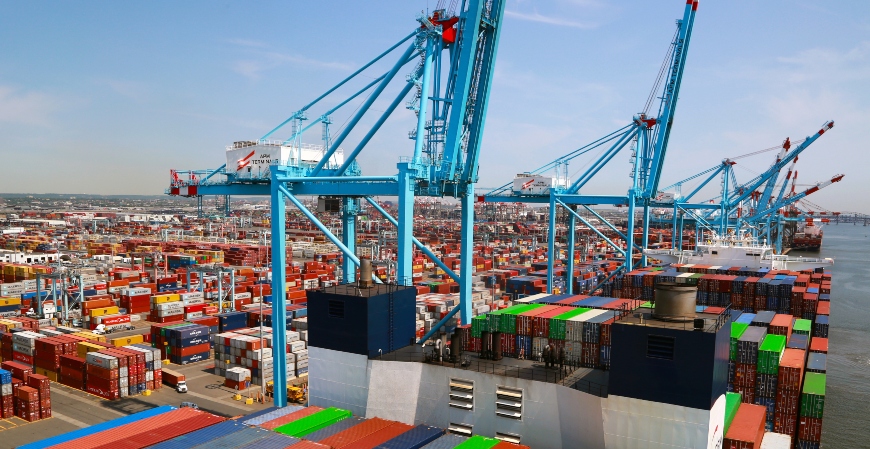Export to the United States
The United States is the world’s largest economy and, in international trade, is the world’s leading importer of goods and the second largest exporter. One of its main trading partners is the European Union, since it is the second largest recipient of U.S. exports and the second largest exporter of goods to the United States.
How to export to the United States?
To export to the United States, it is advisable to be well advised by a freight forwarding company specialized in this market, since U.S. Customs applies numerous customs and security controls, in addition to requiring specific documents depending on the type and origin of the goods.
The United States, a member of the World Trade Organization (WTO) and the Organization for Economic Cooperation and Development (OECD), is the world’s largest economy. In 2020, its gross domestic product reached $20.9 trillion, according to World Bank data.
With a population of over 332 million, GDP per capita stood at US$63,285 in 2020, according to the OECD.
As for the economic outlook, the same OECD notes that U.S. GDP growth projections will be 6% in 2021 and between 4.4% and 5.2% in 2022. This outlook exceeds the International Monetary Fund’s (IMF) projections for global growth in 2021, which it puts at 5.9%, while for 2022 it would be 4.9%.
Looking at the country’s competitiveness, the IMF relegated the United States to second place, behind Singapore, in its 2019 competitiveness index (in 2018 it ranked first). This global ranking of 141 countries measures how a country uses its resources and its ability to provide its inhabitants with a level of prosperity.
Another piece of information to consider is the World Bank’s Doing Business index, which ranks the economies of 190 countries according to the ease of doing business and based on other scores obtained on ten indicators. In this ranking, in 2020, the United States ranked sixth, but in terms of cross-border trade, it dropped to 39th place.
United States, world leader in imports and exports
According to ICEX, the United States is the world’s leading importer of goods and the second largest exporter of goods.
Based on data from the Bureau of Economic Analysis (BEA) for 2020, U.S. merchandise exports reached $1,428.8 billion, down 13.5% from the previous year. As for imports, these stood at $2,337.6 billion, also down 7.1% from 2019, essentially due to the covid-19 pandemic.
Major trading partners of the United States
In terms of U.S. trading partners, the largest volume of U.S. exports is Canada, with 17.8%, followed by the European Union, with 16.2% of the total, Mexico (14.9%), China (8.7%), Japan (4.5%) and the United Kingdom (4.1%).
The United States imports 18.6% from China, 17.8% from the European Union, followed by Mexico (13.9%), Canada (11.6%), Japan (5.1%) and Vietnam (3.4%).
In terms of the exchange of goods between the United States and the European Union, the country that receives the most U.S. exports is Germany (4%), followed by the Netherlands (3.2%), while Spain accounts for 0.9% of the total. As for U.S. imports, 4.9% come from Germany, 2.8% from Ireland and 0.7% from Spain.
Direct trade between the United States and Spain
Exports from Spain to the United States
Regarding direct trade exchanges between the United States and Spain, in 2020, Spanish exports to the American country reached 12,196 M€, experiencing a decrease of 11.08% compared to 2019 (13,716 M€) due to the havoc generated in international trade by covid-19.
By tariff headings, the main chapters of Spanish exports to the United States correspond, from highest to lowest volume, to: machinery and mechanical appliances, electrical appliances and equipment, motor vehicles, fuels and mineral oils, and pharmaceutical products.
Imports from Spain to the United States
Likewise, Spanish imports from the United States also fell by 8.97%, from €15,436 M in 2019 to €14,052 M in 2020.
Spain imports from the United States, from highest to lowest volume, pharmaceuticals, fuels and mineral oils, machinery and mechanical appliances, aircraft and spacecraft, and optical, measuring and medical devices.
A summary of the trade relations between Spain and the United States would be that the North American country is Spain’s main trading partner outside the EU, the sixth destination of Spanish exports of goods (4.7% of the total), and the fifth supplier of Spain (5.1% of the total).

Things to consider when exporting to the U.S.
US Customs and Border Protection (CBP) is the authority that sets and collects duties, taxes and levies on imported goods, and also enforces customs regulations, trade treaties and regulations of other federal agencies.
The customs territory of the United States consists of the 50 states of the Union, the District of Columbia and the Commonwealth of Puerto Rico, and is organized into seven regions, each divided into districts with corresponding points of entry.
If exports to the United States are made by sea, it is advisable to be well advised by a freight forwarder specialized in this type of transport and who knows the particularities of U.S. customs, especially for the clearance of goods to be as agile as possible.
CBP has published a guide for U.S. importers that contains useful information also for companies that want to export to the United States.
When the merchandise arrives in the United States, the consignee company must present the pertinent documents at the port of entry so that the merchandise can be cleared. These procedures can be carried out electronically through the Automated Commercial Environment (ACE), which includes the ACE Import Manifest Documentation section, with information on the documentation and procedures to be carried out depending on whether it is a sea, air or land operation.
The Automated Manifest System (AMS), a document required by the US authorities prior to the shipment and export of goods destined for this country, is processed telematically through this portal.
Another relevant procedure is the Import Security Filing (ISF), also known as 10 + 2, in which the U.S. importer and exporter must provide a series of information about the merchandise and other information about the operation if it is carried out by sea.
As for customs documents to be filed in the United States, in addition to the customs declaration, other customs forms may need to be completed, which can be found on CBP Forms.
Finally, in the area of security, the United States applies the Container Security Initiative (CSI), which is part of the Customs-Trade Partnership Against Terrorism (C-TPAT), the U.S. Customs and Border Protection program aimed at strengthening supply chains, whose compliance means that goods are subject to fewer inspections.
The program’s objectives are achieved through close cooperation between the various actors involved in the international supply chain, such as importers and exporters, shipping companies, freight forwarders, among others.
Spain has participated in this initiative since 2003 and the ports of Algeciras, Barcelona and Valencia are part of this program.
Information and resources







